1�、組件及實現(xiàn)的功能
Keepalived:實現(xiàn)對Haproxy服務的高可用�����,并采用雙主模型配置;
Haproxy:實現(xiàn)對Nginx的負載均衡和讀寫分離;
Nginx:實現(xiàn)對HTTP請求的高速處理;
2、架構設計圖
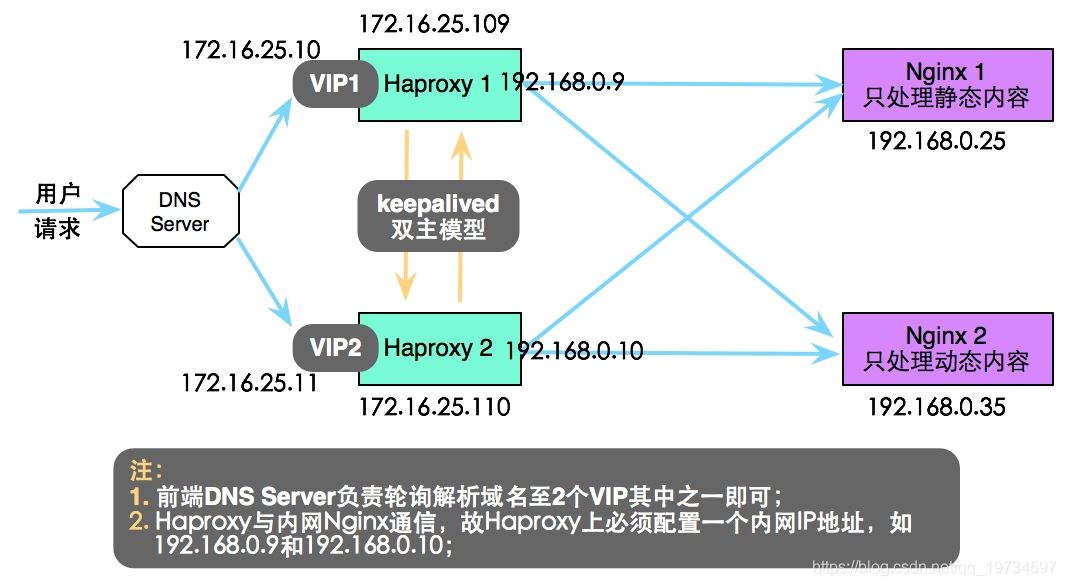
3�����、Keepalived部署
在兩個節(jié)點上都需要執(zhí)行安裝keepalived,命令如下:
$ yum -y install keepalived
修改 172.16.25.109 節(jié)點上 keepalived.conf 文件配置��,命令如下
$ vim /etc/keepalived/keepalived.conf
修改后的內容如下:
! Configuration File for keepalived
global_defs {
notification_email {
root@localhost
}
notification_email_from admin@lnmmp.com
smtp_connect_timeout 3
smtp_server 127.0.0.1
router_id LVS_DEVEL
}
vrrp_script chk_maintaince_down {
script "[[ -f /etc/keepalived/down ]] && exit 1 || exit 0"
interval 1
weight 2
}
vrrp_script chk_haproxy {
script "killall -0 haproxy"
interval 1
weight 2
}
vrrp_instance VI_1 {
interface eth0
state MASTER
priority 100
virtual_router_id 125
garp_master_delay 1
authentication {
auth_type PASS
auth_pass 1e3459f77aba4ded
}
track_interface {
eth0
}
virtual_ipaddress {
172.16.25.10/16 dev eth0 label eth0:0
}
track_script {
chk_haproxy
}
notify_master "/etc/keepalived/notify.sh master 172.16.25.10"
notify_backup "/etc/keepalived/notify.sh backup 172.16.25.10"
notify_fault "/etc/keepalived/notify.sh fault 172.16.25.10"
}
vrrp_instance VI_2 {
interface eth0
state BACKUP
priority 99
virtual_router_id 126
garp_master_delay 1
authentication {
auth_type PASS
auth_pass 7615c4b7f518cede
}
track_interface {
eth0
}
virtual_ipaddress {
172.16.25.11/16 dev eth0 label eth0:1
}
track_script {
chk_haproxy
chk_maintaince_down
}
notify_master "/etc/keepalived/notify.sh master 172.16.25.11"
notify_backup "/etc/keepalived/notify.sh backup 172.16.25.11"
notify_fault "/etc/keepalived/notify.sh fault 172.16.25.11"
}
同理修改 172.16.25.110 節(jié)點上 keepalived.conf 配置��,內容如下:
! Configuration File for keepalived
global_defs {
notification_email {
root@localhost
}
notification_email_from admin@lnmmp.com
smtp_connect_timeout 3
smtp_server 127.0.0.1
router_id LVS_DEVEL
}
vrrp_script chk_maintaince_down {
script "[[ -f /etc/keepalived/down ]] && exit 1 || exit 0"
interval 1
weight 2
}
vrrp_script chk_haproxy {
script "killall -0 haproxy"
interval 1
weight 2
}
vrrp_instance VI_1 {
interface eth0
state BACKUP
priority 99
virtual_router_id 125
garp_master_delay 1
authentication {
auth_type PASS
auth_pass 1e3459f77aba4ded
}
track_interface {
eth0
}
virtual_ipaddress {
172.16.25.10/16 dev eth0 label eth0:0
}
track_script {
chk_haproxy
chk_maintaince_down
}
notify_master "/etc/keepalived/notify.sh master 172.16.25.10"
notify_backup "/etc/keepalived/notify.sh backup 172.16.25.10"
notify_fault "/etc/keepalived/notify.sh fault 172.16.25.10"
}
vrrp_instance VI_2 {
interface eth0
state MASTER
priority 100
virtual_router_id 126
garp_master_delay 1
authentication {
auth_type PASS
auth_pass 7615c4b7f518cede
}
track_interface {
eth0
}
virtual_ipaddress {
172.16.25.11/16 dev eth0 label eth0:1
}
track_script {
chk_haproxy
}
notify_master "/etc/keepalived/notify.sh master 172.16.25.11"
notify_backup "/etc/keepalived/notify.sh backup 172.16.25.11"
notify_fault "/etc/keepalived/notify.sh fault 172.16.25.11"
}
# vi /etc/keepalived/notify.sh
#!/bin/bash
# Author: Jason.Yu <admin@lnmmp.com>
# description: An example of notify script
#
contact='root@localhost'
notify() {
mailsubject="`hostname` to be $1: $2 floating"
mailbody="`date '+%F %H:%M:%S'`: vrrp transition, `hostname` changed to be $1"
echo $mailbody | mail -s "$mailsubject" $contact
}
case "$1" in
master)
notify master $2
/etc/rc.d/init.d/haproxy restart
exit 0
;;
backup)
notify backup $2 # 在節(jié)點切換成backup狀態(tài)時�,無需刻意停止haproxy服務��,防止chk_maintaince和chk_haproxy多次對haproxy服務操作�;
exit 0
;;
fault)
notify fault $2 # 同上
exit 0
;;
*)
echo 'Usage: `basename $0` {master|backup|fault}'
exit 1
;;
esac
在兩個節(jié)點上執(zhí)行 keepalived 啟動命令,命令如下:
$ service keepalived start
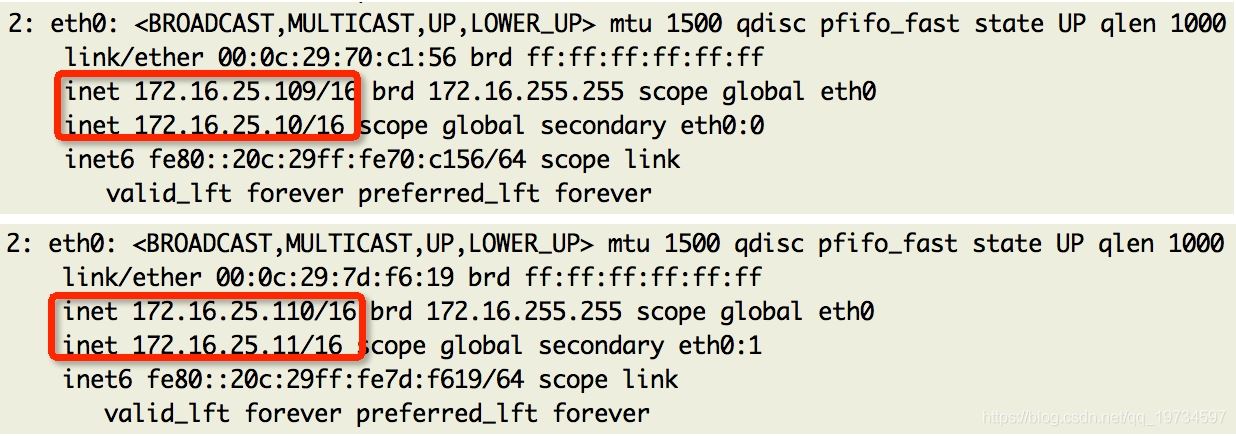
4、Haproxy部署
在兩個節(jié)點上都需要執(zhí)行安裝 HAProxy����,命令如下:
修改 172.16.25.109 和 172.16.25.110 節(jié)點上 haproxy.cfg 文件配置(兩節(jié)點配置文件內容一致)����,命令如下:
$ vim /etc/haproxy/haproxy.cfg
配置文件內容如下:
global
log 127.0.0.1 local2
chroot /var/lib/haproxy
pidfile /var/run/haproxy.pid
maxconn 4000
user haproxy
group haproxy
daemon # 以后臺程序運行�;
defaults
mode http # 選擇HTTP模式�,即可進行7層過濾�����;
log global
option httplog # 可以得到更加豐富的日志輸出���;
option dontlognull
option http-server-close # server端可關閉HTTP連接的功能��;
option forwardfor except 127.0.0.0/8 # 傳遞client端的IP地址給server端�����,并寫入“X-Forward_for”首部中��;
option redispatch
retries 3
timeout http-request 10s
timeout queue 1m
timeout connect 10s
timeout client 1m
timeout server 1m
timeout http-keep-alive 10s
timeout check 10s
maxconn 30000
listen stats
mode http
bind 0.0.0.0:1080 # 統(tǒng)計頁面綁定1080端口����;
stats enable # 開啟統(tǒng)計頁面功能;
stats hide-version # 隱藏Haproxy版本號�;
stats uri /haproxyadmin?stats # 自定義統(tǒng)計頁面的訪問uri�����;
stats realm Haproxy\ Statistics # 統(tǒng)計頁面密碼驗證時的提示信息����;
stats auth admin:admin # 為統(tǒng)計頁面開啟登錄驗證功能;
stats admin if TRUE # 若登錄用戶驗證通過�����,則賦予管理功能����;
frontend http-in
bind *:80
mode http
log global
option httpclose
option logasap
option dontlognull
capture request header Host len 20
capture request header Referer len 60
acl url_static path_beg -i /static /p_w_picpaths /javascript /stylesheets
acl url_static path_end -i .jpg .jpeg .gif .png .css .js .html
use_backend static_servers if url_static # 符合ACL規(guī)則的����,請求轉入后端靜態(tài)服務器
default_backend dynamic_servers # 默認請求轉入后端動態(tài)服務器
backend static_servers
balance roundrobin
server imgsrv1 192.168.0.25:80 check maxconn 6000 # 靜態(tài)服務器����,可配置多臺���,還可設置權重weight���;
backend dynamic_servers
balance source # 對于動態(tài)請求利用source調度算法��,可一定程度上實現(xiàn)session保持���;但最好利用cookie綁定的方式實現(xiàn)session保持
server websrv1 192.168.0.35:80 check maxconn 1000 # 動態(tài)服務器,可配置多臺����,還可設置權重weight;
兩個節(jié)點執(zhí)行啟動服務�,命令如下:
5����、Nginx部署
yum -y groupinstall “Development tools”
yum -y groupinstall “Server Platform Development”
yum install gcc openssl-devel pcre-devel zlib-devel
groupadd -r nginx
useradd -r -g nginx -s /sbin/nologin -M nginx
tar xf nginx-1.4.7.tar.gz
cd nginx-1.4.7
mkdir -pv /var/tmp/nginx
./configure \
--prefix=/usr \
--sbin-path=/usr/sbin/nginx \
--conf-path=/etc/nginx/nginx.conf \
--error-log-path=/var/log/nginx/error.log \
--http-log-path=/var/log/nginx/access.log \
--pid-path=/var/run/nginx/nginx.pid \
--lock-path=/var/lock/nginx.lock \
--user=nginx \
--group=nginx \
--with-http_ssl_module \
--with-http_flv_module \
--with-http_stub_status_module \
--with-http_gzip_static_module \
--http-client-body-temp-path=/var/tmp/nginx/client/ \
--http-proxy-temp-path=/var/tmp/nginx/proxy/ \
--http-fastcgi-temp-path=/var/tmp/nginx/fcgi/ \
--http-uwsgi-temp-path=/var/tmp/nginx/uwsgi \
--http-scgi-temp-path=/var/tmp/nginx/scgi \
--with-pcre
make && make install
配置服務腳本
vi /etc/init.d/nginx # 配置服務腳本
#!/bin/sh
#
# nginx - this script starts and stops the nginx daemon
#
# chkconfig: - 85 15
# description: Nginx is an HTTP(S) server, HTTP(S) reverse \
# proxy and IMAP/POP3 proxy server
# processname: nginx
# config: /etc/nginx/nginx.conf
# config: /etc/sysconfig/nginx
# pidfile: /var/run/nginx.pid
# Source function library.
. /etc/rc.d/init.d/functions
# Source networking configuration.
. /etc/sysconfig/network
# Check that networking is up.
[ "$NETWORKING" = "no" ] && exit 0
nginx="/usr/sbin/nginx"
prog=$(basename $nginx)
NGINX_CONF_FILE="/etc/nginx/nginx.conf"
[ -f /etc/sysconfig/nginx ] && . /etc/sysconfig/nginx
lockfile=/var/lock/subsys/nginx
make_dirs() {
# make required directories
user=`nginx -V 2>&1 | grep "configure arguments:" | sed 's/[^*]*--user=\([^ ]*\).*/\1/g' -`
options=`$nginx -V 2>&1 | grep 'configure arguments:'`
for opt in $options; do
if [ `echo $opt | grep '.*-temp-path'` ]; then
value=`echo $opt | cut -d "=" -f 2`
if [ ! -d "$value" ]; then
# echo "creating" $value
mkdir -p $value && chown -R $user $value
fi
fi
done
}
start() {
[ -x $nginx ] || exit 5
[ -f $NGINX_CONF_FILE ] || exit 6
make_dirs
echo -n $"Starting $prog: "
daemon $nginx -c $NGINX_CONF_FILE
retval=$?
echo
[ $retval -eq 0 ] && touch $lockfile
return $retval
}
stop() {
echo -n $"Stopping $prog: "
killproc $prog -QUIT
retval=$?
echo
[ $retval -eq 0 ] && rm -f $lockfile
return $retval
}
restart() {
configtest || return $?
stop
sleep 1
start
}
reload() {
configtest || return $?
echo -n $"Reloading $prog: "
killproc $nginx -HUP
RETVAL=$?
echo
}
force_reload() {
restart
}
configtest() {
$nginx -t -c $NGINX_CONF_FILE
}
rh_status() {
status $prog
}
rh_status_q() {
rh_status >/dev/null 2>&1
}
case "$1" in
start)
rh_status_q && exit 0
$1
;;
stop)
rh_status_q || exit 0
$1
;;
restart|configtest)
$1
;;
reload)
rh_status_q || exit 7
$1
;;
force-reload)
force_reload
;;
status)
rh_status
;;
condrestart|try-restart)
rh_status_q || exit 0
;;
*)
echo $"Usage: $0 {start|stop|status|restart|condrestart|try-restart|reload|force-reload|configtest}"
exit 2
esac
chmod +x /etc/init.d/nginx # 復***務腳本執(zhí)行權限
vi /etc/nginx/nginx.conf # 編輯主配置文件
worker_processes 2;
error_log /var/log/nginx/nginx.error.log;
pid /var/run/nginx.pid;
events {
worker_connections 1024;
}
http {
include mime.types;
default_type application/octet-stream;
log_format main '$remote_addr - $remote_user [$time_local] "$request" '
'$status $body_bytes_sent "$http_referer" '
'"$http_user_agent" "$http_x_forwarded_for"';
sendfile on;
keepalive_timeout 65;
server {
listen 80;
server_name xxrenzhe.lnmmp.com;
access_log /var/log/nginx/nginx.access.log main;
location / {
root /www/lnmmp.com;
index index.php index.html index.htm;
}
error_page 404 /404.html;
error_page 500 502 503 504 /50x.html;
location = /50x.html {
root /www/lnmmp.com;
}
location ~ \.php$ {
root /www/lnmmp.com;
fastcgi_pass 127.0.0.1:9000;
fastcgi_index index.php;
fastcgi_param SCRIPT_FILENAME $document_root$fastcgi_script_name;
include fastcgi_params;
}
}
}
vi /etc/nginx/fastcgi_params # 編輯fastcgi參數(shù)文件
fastcgi_param GATEWAY_INTERFACE CGI/1.1;
fastcgi_param SERVER_SOFTWARE nginx;
fastcgi_param QUERY_STRING $query_string;
fastcgi_param REQUEST_METHOD $request_method;
fastcgi_param CONTENT_TYPE $content_type;
fastcgi_param CONTENT_LENGTH $content_length;
fastcgi_param SCRIPT_FILENAME $document_root$fastcgi_script_name;
fastcgi_param SCRIPT_NAME $fastcgi_script_name;
fastcgi_param REQUEST_URI $request_uri;
fastcgi_param DOCUMENT_URI $document_uri;
fastcgi_param DOCUMENT_ROOT $document_root;
fastcgi_param SERVER_PROTOCOL $server_protocol;
fastcgi_param REMOTE_ADDR $remote_addr;
fastcgi_param REMOTE_PORT $remote_port;
fastcgi_param SERVER_ADDR $server_addr;
fastcgi_param SERVER_PORT $server_port;
fastcgi_param SERVER_NAME $server_name;
啟動服務
service nginx configtest # 服務啟動前先驗證配置文件是否正確
service nginx start
ps -ef |grep nginx # 檢查nginx進程���,尤其是worker進程是否與worker_processes值一致
ss -antupl |grep 80 # 檢查服務端口是否啟動
6��、訪問驗證
Haproxy 統(tǒng)計頁面測試

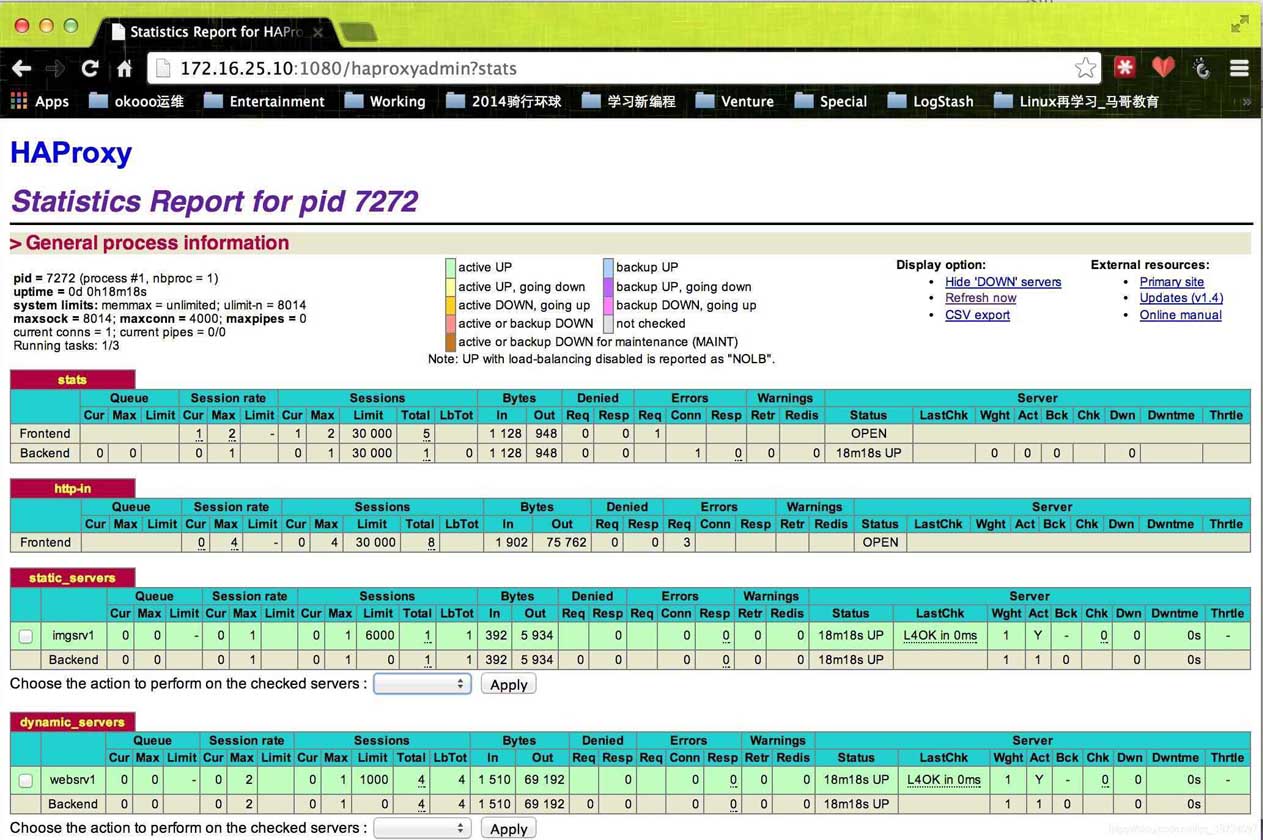
動靜分離測試

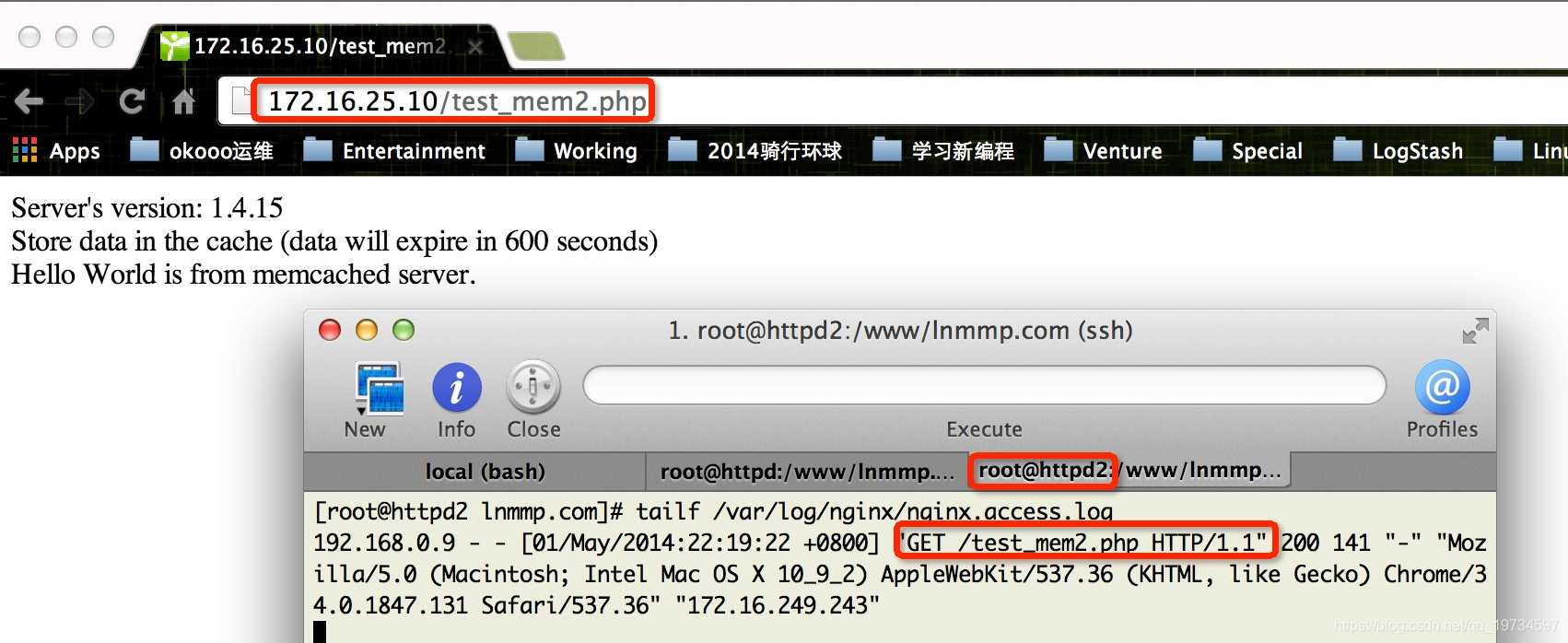
高可用測試
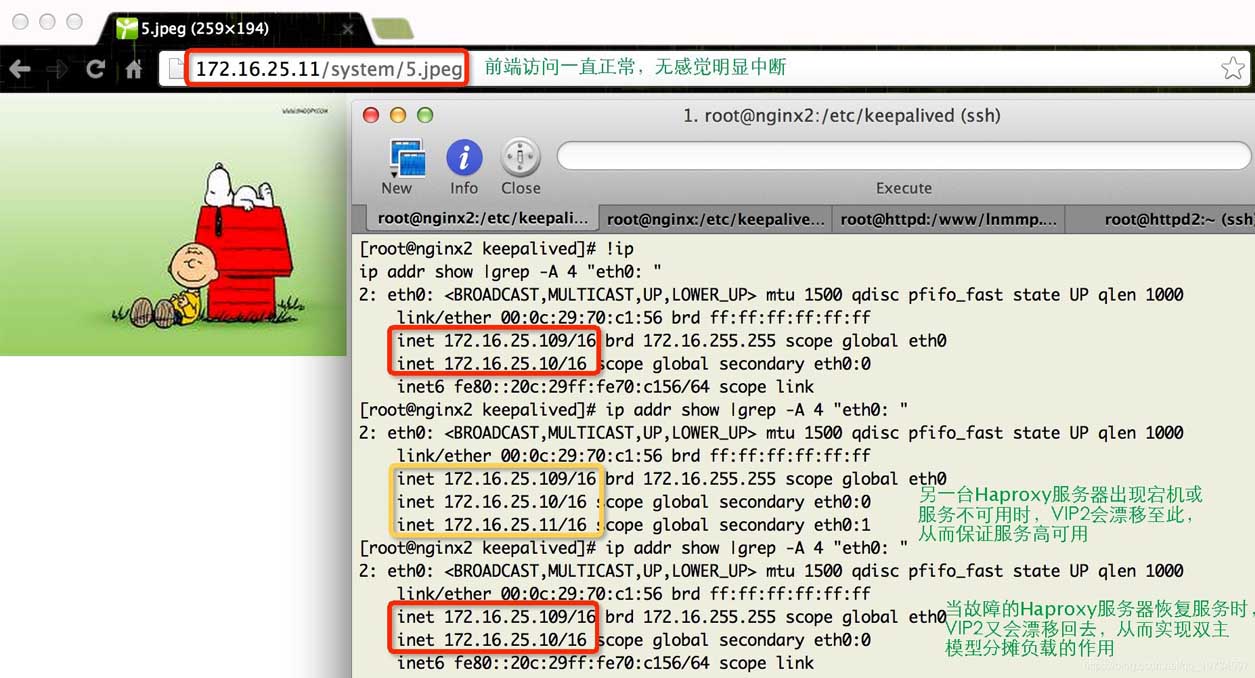
到此 Nginx高可用集群構建(Keepalived+Haproxy+Nginx)介紹完成�����。
到此這篇關于Nginx實現(xiàn)高可用集群構建(Keepalived+Haproxy+Nginx)的文章就介紹到這了,更多相關Nginx 高可用集群內容請搜索腳本之家以前的文章或繼續(xù)瀏覽下面的相關文章希望大家以后多多支持腳本之家�!